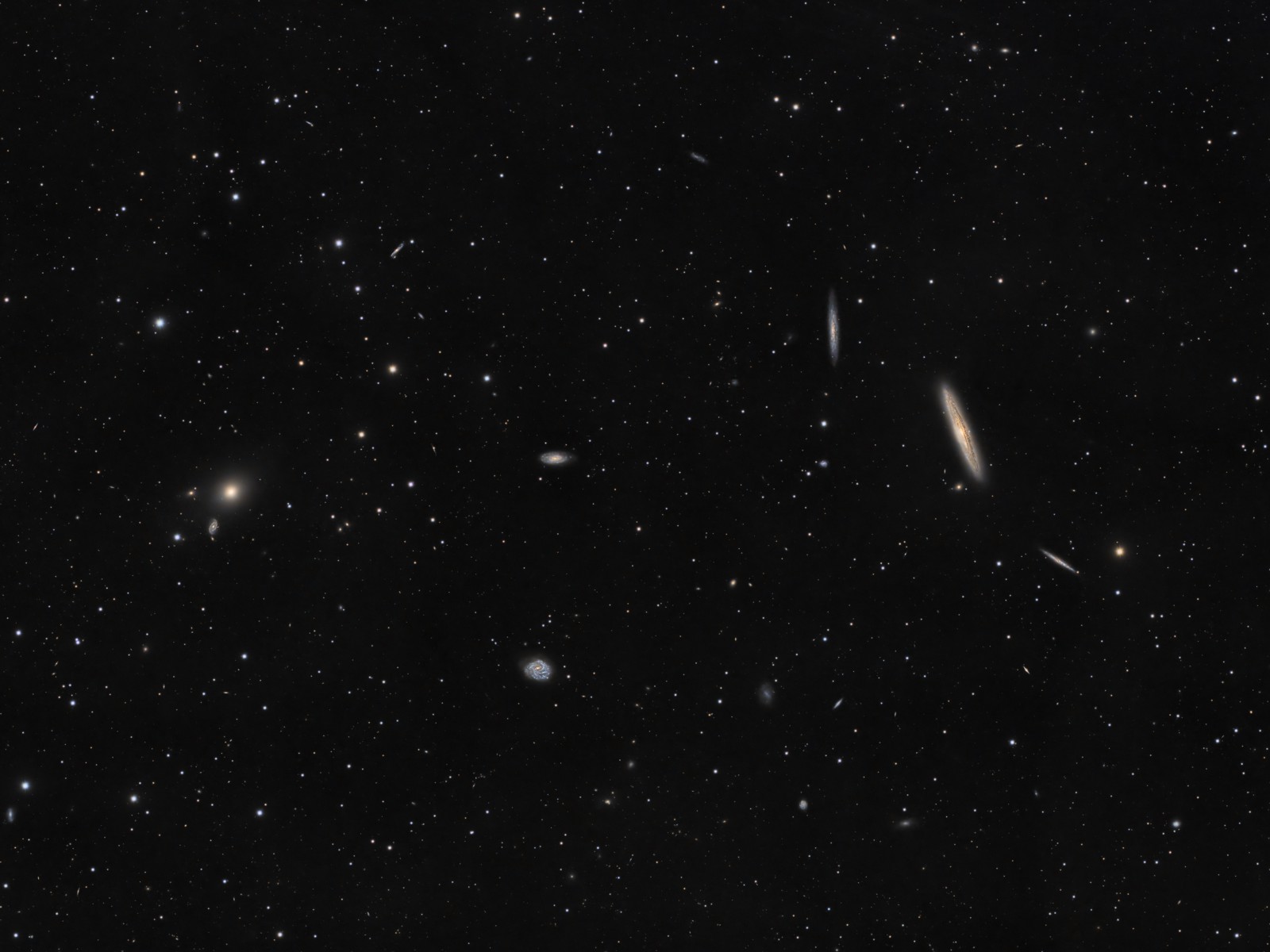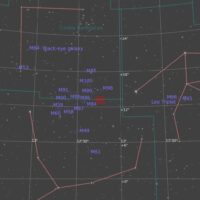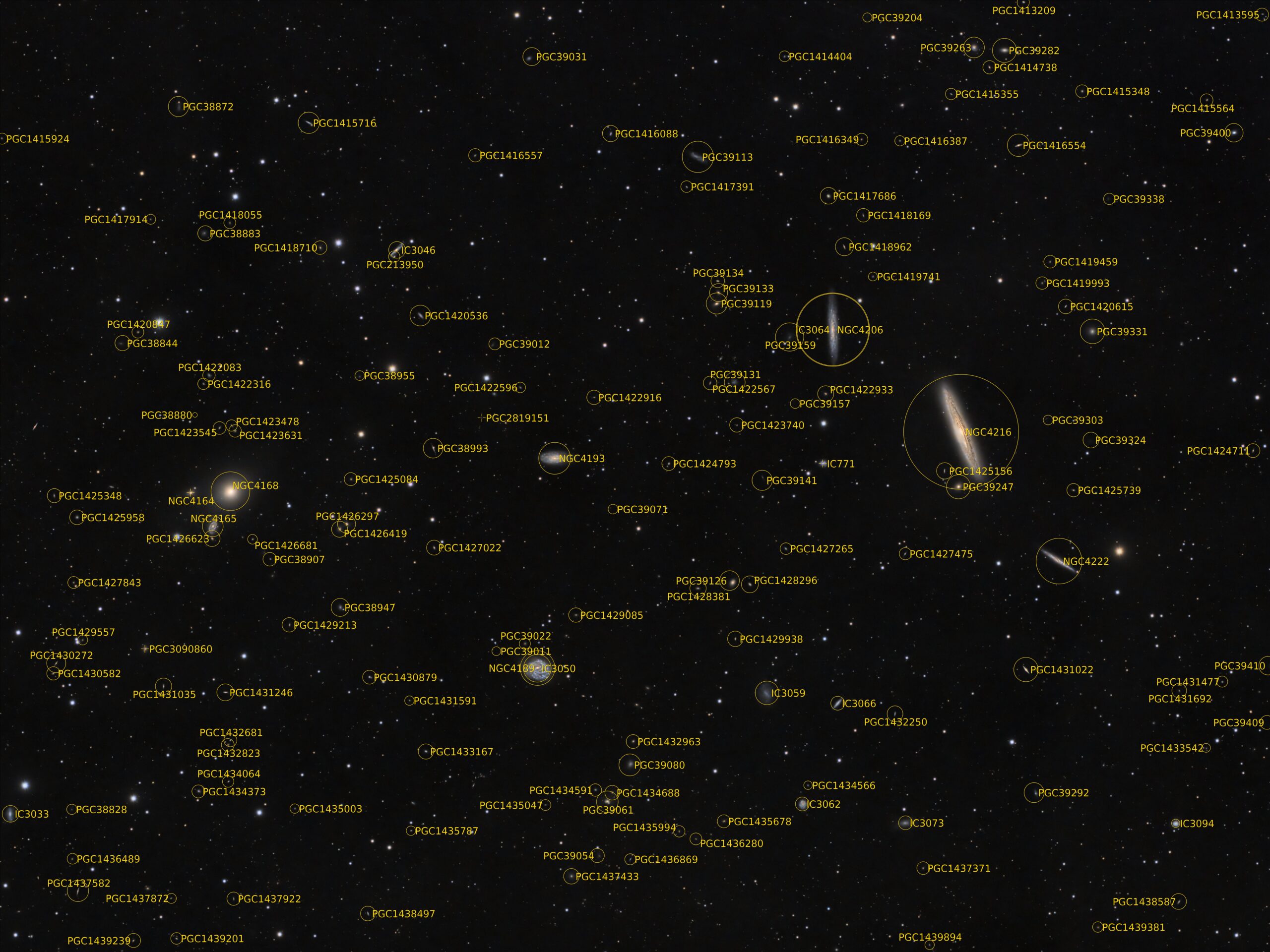NGC 4216 and Friends

Click image for full size version
March 20, 2023
Galaxy season is in full swing, and this image shows hundreds of them in the Virgo Cluster. See the annotated image for catalogue numbers and locations of the many galaxies dotted throughout the filed. This field of view sits right on the southern border of Coma Berenices, where it meets Virgo.
The most prominent galaxy in this image is NGC 4216. It is a spiral galaxy inclined towards us, and reveals lots of details in its dust lanes. It’s about the size of the Milky Way, and is roughly at the centre of the Virgo Galaxy Cluster at a distance of about 55 million light years.. It’s flanked by NGC 4206 to its upper left and NGC 4222 to its lower right. Another spiral galaxy that shows interesting spiral detail is below left of centre, NGC 4189. It also shows a spread out haze to its upper left.
Tekkies:
Acquisition, focusing, and control of Paramount MX mount with N.I.N.A., TheSkyX; unguided. Focus with Optec DirectSync motors and controller. Equipment control with PrimaLuce Labs Eagle 4 Pro computer. All pre-processing and processing in PixInsight. Acquired from my SkyShed in Guelph. Good transparency and seeing. Acquired February 13 – March 15, 2023 under a moonless sky.
Sky-Watcher Esprit 150 f/7 refractor and QHY600M camera with Optolong UV/IR filter
Tak FSQ-106 @ f/5 (530mm), QHY-367C Pro One-shot colour, Optolong UV/IR filter
114x5m OSC = 9hr30m
Preprocessing: The WeightedBatchPreProcessing script was used to perform calibration, cosmetic correction, weighting, registration, local normalization and integration of all frames.
Alignment of Master Frames: DrizzleIntegration was applied to the OSC frames (within WeightedBatchPreProcessing), and the result was aligned to the Luminance master with StarAlignment. This yielded aligned Lum and Colour masters.
Gradient Removal: DynamicBackgroundExtraction was applied to both masters.
Colour Calibration: SpecrophotometricColorCalibration was used to calibrate the OSC master.
Deconvolution: BlurXterminator was used on each master with a custom psf FWHM determined with the PSFImage script, and star sharpening set to 0.10 with “Correct First” selected.
Linear Noise Reduction: NoiseXterminator was applied to each image with settings Amount=0.9 and Detail=0.15
Stretching: HistogramTransformation was applied to each image to make a pleasing yet bright image.
Nonlinear Processing
Luminance addition: LRGBCombination was applied to replace the lightness of the RGB image with the Luminance master.
Star Removal: StarXterminator was used to remove the stars, with Unscreen selected
Nonlinear Noise Reduction: NoiseXterminator was used to reduce noise in the background areas of the image with settings Amount=0.9 and Detail=0.1
Contrast Enhancement: Using a mask to select NGC 4216, HDRMultiscaleTransform was applied to a clone of the image at a scale of 4. The result was blended 1:1 with the original using the same mask, followed by LocalHistogramEqualization twice. A Contrast Limit of 1.5 and 1 iteration were used for each LHE application (scale 40, strength 0.25; scale 100, strength 0.25)
Sharpening: A mask was used to select all the prominent galaxies and protect the remainder of the image. MultiscaleMedianTransform was used to sharpen Layers 1 – 5 with strengths of 0.03, 0.05, 0.05, 0.04, and 0.03, respectively.
Star Restoration: PixelMath expression combine(starless, stars, op_screen()) was used to combine the starless and stars-only images created with StarXterminator.
Final Steps: Background, galaxy and star brightness, contrast and saturation were adjusted in several iterations using CurvesTransformation with masks as required. ICCProfileTransformation (sRGB IEC61966-2.1; Relative Colorimetric with black point compensation) was applied prior to saving as a jpg. Image was annotated with the AnnotateImage script. Finder chart was made using the FindingChart process.








So many cool galaxies in this field, love it!!
Lovely little gems!
Beautiful image! Of course!